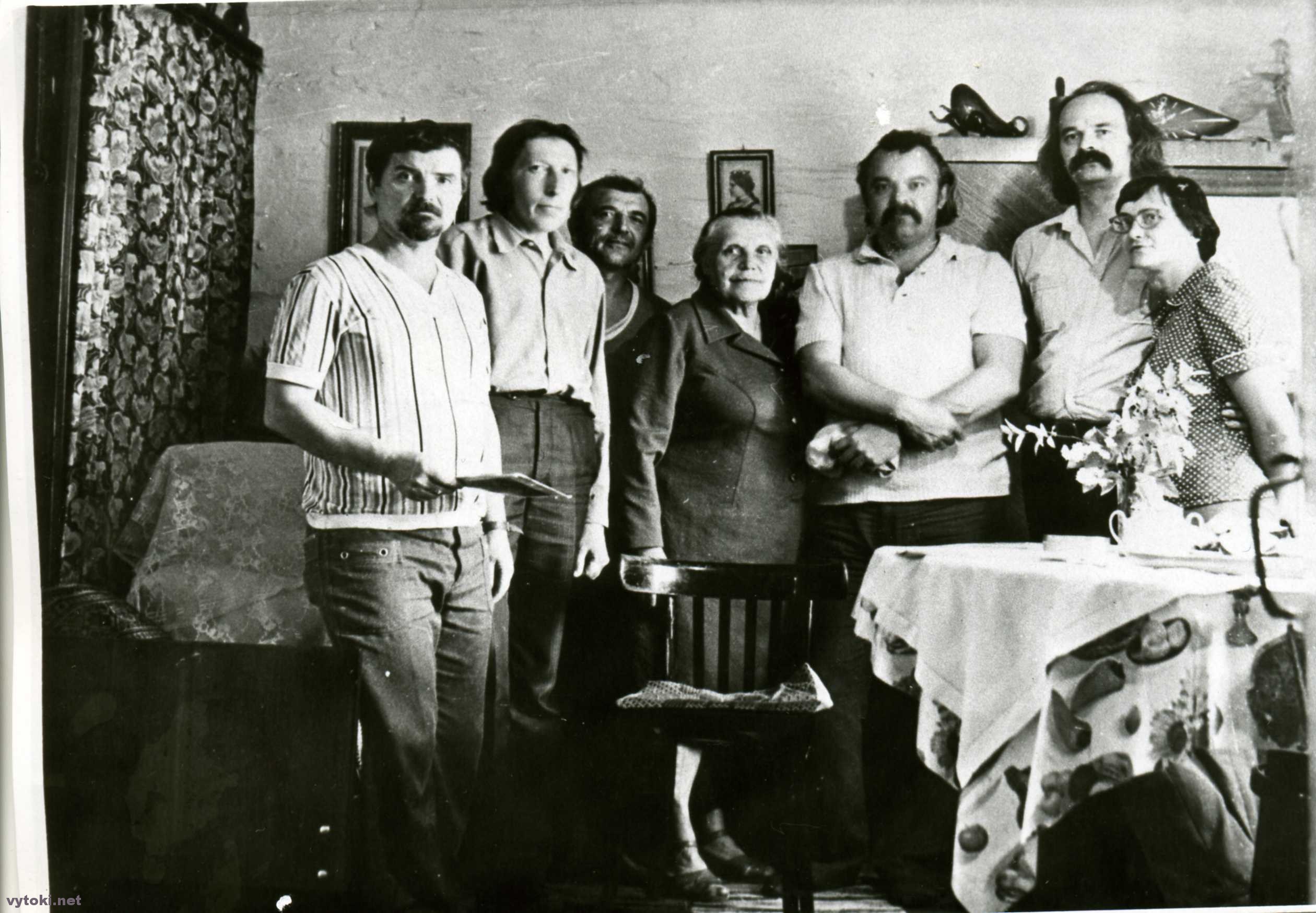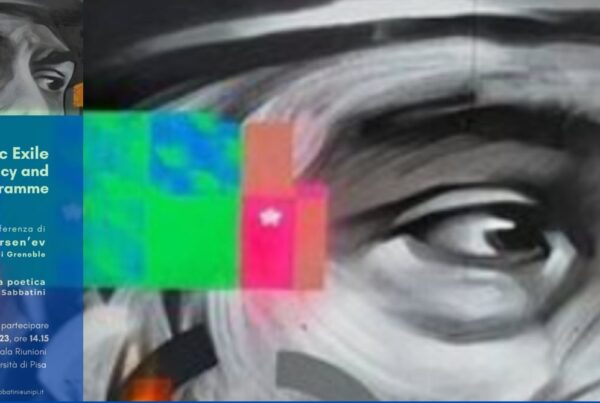
Artists from Minsk visiting Łarysa Hienijuš at her home in Zelva, 24 June 1981. Source vytoki.net.
The Belarusian samizdat was less influential than its Russian, Ukrainian, or Lithuanian equivalents but it nevertheless played a role in the political and cultural life of the Belarusian Soviet Socialist Republic. Unlike other parts of the USSR, literature which was not intended for publication never ceased to exist in Soviet Belarus.
Nikolaj Glazkov, the Russian poet who coined the word “samizdat”, circulated his typescripts in the late 1940s to early 1950s. In the same period, Nil Hilevič (at the time a student of Minsk Pedagogical College) wrote his poem Paboishcha (The Battle) describing a fight between a group of students and a group of young workers (cf. Hilevich 2008: 89-93). The poem could never have been officially printed, but nevertheless became popular among his fellow students. Student circles continued to generate poetry “unintended-for-publication”: in 1962, a collection of erotic poetry called Novyi dekameron (The New Decameron) was put together by students of the Belarusian State University; in the late 1960s Ivan Klimiankoŭ versified his experiences of the same university.
There was no long-standing periodical in the Belarusian samizdat such as “Khronika tekushchikh sobytii” (The Chronicle of Current Events) or “Lietuvos katalikų bažnyčios kronika” (The Chronicle of the Catholic Church in Lithuania). Periodicals lasted no longer than a couple of years. The earliest was probably the handwritten “Padsniezhnik” (Snowdrop) produced by Mikoła Jermałovich in 1963-1964. In 1975-1976 Jermałovich renewed his samizdat activities with Hutarka (The Talk) of which copies made by artist Jaŭhien Kulik were distributed. In many cases samizdat publications were confiscated by the KGB and never returned to their creators or owners. Such was the fate of a handwritten almanac from Navapolack named Błakitny likhtar (Blue Lantern, 1971-1974), all issues of which disappeared (the authors were threatened with prosecution unless they stopped their activities; cf. Mudroŭ 2005: 6-42).
The circulation of samizdat literature, including periodicals, in the late “stagnation” years (1982-1984) increased – cf. “Mistyka”(Mystics, Hrodna, 1982-1983), “Idiot” (Vitsiebsk, published from 1983), and “Nabojni” (Slonim, 1984) – but print runs were short and circulation was limited to family and friends to avoid KGB surveillance. A catalogue of Belarusian samizdat periodicals was published in 1998 (Łaŭryk and Androsik 1998). Most probably, however, it is far from complete as there has been a general lack of research on Belarusian samizdat. For example, there are no entries on the religious samizdat in the first part of the catalogue (covering the years 1971-1987). Jewish Belarusian samizdat is also missing from the catalogue, although it is possible that Jewish samizdat was represented only by non-periodical publications.
The most influential books of the Belarusian samizdat include: Pa sladakh adnaho mifa (Tracing One Myth, 1968) by Mikoła Jermałovich, Polozhenie v Belorusi, 1974 (The Situation in Belarus, 1974) by Hienrykh Rakutovich (real name Zianon Pazniak), Pis’mo russkomu drugu (Letter to a Russian Friend, 1977, circulated anonymously, English translation published in London in 1979) by Alaksiej Kaŭka and Rodnaie słova i maralna-estetyčny prahres (Native Speech and Progress in Morals and Aesthetics, 1984, published in 1985 in London) by Aleh Biembiel.
The authors of these works defended Belarusian history (as in the case of Jermalovich), from real or imagined falsification, or the Belarusian language, from extinction, arguing in favour of schools and books in Belarusian. Several shorter papers were circulated in samizdat by the most well-known Belarusian dissident Michaś Kukabaka, however, most of Kukabaka’s readers lived in Russia or in the West and his works were little known in his own country during the 1970s. Probably the most popular work of literary samizdat was Skaz pra Łysuju haru (Tale of the Bald Mountain, 1970s) by Nil Hilevich (circulated anonymously). This satirical poem describes the dachas (summerhouse colony) of members of the writers’ union based in Minsk. The poem is filled with politically safe jokes on how certain writers arranged their plots of land. Still, the work was not published in Belarus until the late 1980s (cf. Hilevich 2008: 209-216).
The poetry of Łarysa Hienijush was in part circulated via the samizdat, although some of the poet’s work was also published officially. Łarysa Hienijush wrote an autobiography, describing in great detail her time in a GULAG but it had limited circulation before its official publication in 1990. Like periodicals, non-periodical literary samizdat works experienced an upsurge in the very late “stagnation” years. Aleksandr Kozik (later known as Aleś Arkush) produced a book of his verses Dykhaniia (Breathings, 1983; cf. Arkush 2007: 3-4) in Zhodzina and Aleksandr Romanov published his collection of ironical short stories Proletarii dukha (Proletarians of the Spirit, 1984) in Hrodna.
As with periodicals, religious and Jewish non-periodical samizdat publications have not been catalogued to date. An outstanding example of religious samizdat was Svidetel’stvo obvineniia (Witness for the Prosecution) by the Orthodox Deacon Vladimir Rusak. The book describes the persecution of the Russian Orthodox Church by Bolsheviks. It was written and circulated in Moscow, but Rusak was born and raised in Belarus, and served there as a priest from 1982 to 1984. In 1986 Rusak was sentenced to two and a half years in prison.
Individual samizdat documents either produced in Belarus or produced elsewhere but describing the situation in Belarus are relatively abundant, and can be found, for example, in the collection “Arkhiv samizdata Radio Svoboda” (Radio Liberty Samizdat Archives). Both “The Chronicle of Current Events” and “The Chronicle of the Catholic Church in Lithuania” often reported on the Belarusian situation.
Writing relating to Belarus was produced for dissemination in all parts of the Soviet Union. Alongside the local samizdat, Russian samizdat works circulated in Belarus quite widely. Among those who organised the copying of Russian samizdat were Mikoła Iakimovich (Minsk, from 1975) and Naum Nim (Vitsiebsk, late 1970s and early 1980s). Ukrainian samizdat had some influence, for instance, the work of Ivan Dziuba Internationalism or Russification (1965, published in London in 1968) made a great impression both on Nil Hilevich (cf. Hilevič 2008: 194-198) and on the group of intellectuals in the Belarusian Academy of Sciences.
Apart from periodicals and books, other kinds of publications circulated in samizdat. For example, the artist Uładzimir Krukoŭski created postcards which were later reprinted in tamizdat by Belarusian emigrants. In March 2018 in Greifswald (Germany), the Belarusian researcher Tatsiana Astrouskaia discussed her PhD thesis Between Dissent and Conformity, Between Uncensored and Official. The Intelligentsiia, Samizdat, and Nonconformist Discourses in the Belarusian Soviet Socialist Republic (1968-1988). When this thesis is published, more information on the Belarusian samizdat will become available (cf. Astrouskaia 2019).
Uladzimir Valodzin
[30th June 2021]
Bibliography
- Arkush A., Askiepki vialikaha malunku, Łohvinaŭ, Minsk 2007.
- Astrouskaia T., Cultural Dissent in Soviet Belarus (1968-1988): Intelligentsiia, Samizdat and Nonconformist Discourses, Harrassowitz, Wiesbaden 2019.
- Dziarnovich A. (ed.), Nonkanfarmizm u Biełarusi, 1953-1985: Daviednik. Tom 1, Athenaeum, Minsk 2004.
- Hardzijenka N., Sciepanienka P. (eds.), Michaś Kukabaka, Centr dasledvanniaŭ hramadzianskaj supolnasci Biełarusi, Minsk 2016.
- Hilevich N., Zbor tvoraŭ u 23 tamach. Tom 23. Mizh rospachchu i nadziejaj. Abrys projdzienaha shlakhu ŭ śviatle adnoj mary, Nasha buduchynia, Vilnia 2008.
- Łaŭryk J., Androsik L. (eds.), Pazacenzurny peryjadychny druk Biełarusi (1971-1990): Kataloh, BHAKC, Miensk 1998.
- Mudroŭ V., Pieratvoranyia ŭ popieł: ese, fantasmahoryi, uspaminy, Łohvinaŭ, Minsk 2005.
Updated version of: Volodin V., Belarusian samizdat (1960s — early 1980s), in C. Pieralli, T. Spignoli, F. Iocca, G. Larocca, G. Lo Monaco (eds.), Alle due sponde della cortina di ferro. Le culture del dissenso e la definizione dell’identità europea nel secondo Novecento tra Italia, Francia e URSS (1956-1991), goWare, Firenze 2019: 120-123.
To cite this article:
Uladzimir Valodzin, Belarusian samizdat (1960s – early 1980s), in Voci libere in URSS. Letteratura, pensiero, arti indipendenti in Unione Sovietica e gli echi in Occidente (1953-1991), a cura di C. Pieralli, M. Sabbatini, Firenze University Press, Firenze 2021-, <vocilibereurss.fupress.net>.
eISBN 978-88-5518-463-2
© 2021 Author(s)
Content license: CC BY 4.0




